HIGHLIGHTS: DECEMBER 6, 2024
• USDEC MENA cheese and ingredient mission
• USDEC reinforces ties with Mexico ahead of U.S. administration switch
• October U.S. dairy exports
• Global plastics treaty elusive
• USDEC defends dairy at Codex
• Singapore upholds generic nature of “parmesan”
• Membership renewal notifications emailed
• Market Summary: China, WMP drive GDT
• Denmark approves livestock emissions tax
• November revisions to USDEC Export Guide
• China expands probe into EU dairy subsidies
• Opposition grows to EU-Mercosur trade deal
• Bord Bia wins contract to promote EU dairy in Asia
• Company news: a2MC, Nestlé, DFA, Starbucks
Featured
USDEC MENA mission yields more than 700 meetings between members and potential buyers
Prior to the Thanksgiving holiday, USDEC representatives from Arlington and the Middle East/North Africa (MENA) office conducted a three-city, four-day expedition aimed at linking U.S. dairy ingredient and cheese suppliers with MENA buyers to build relationships and generate business. Representatives from 16 USDEC member companies attended the U.S. Dairy Supplier Mission to the region, holding 721 individual one-on-one meetings over the course of four days of meetings.
A massive amount of work went into organizing and planning the event. For example, to maximize the encounters, the MENA region staff prequalified each of the buyers and scheduled the meetings in advance. Buyers from 152 companies (representing 16 countries in the region) participated over the four days.
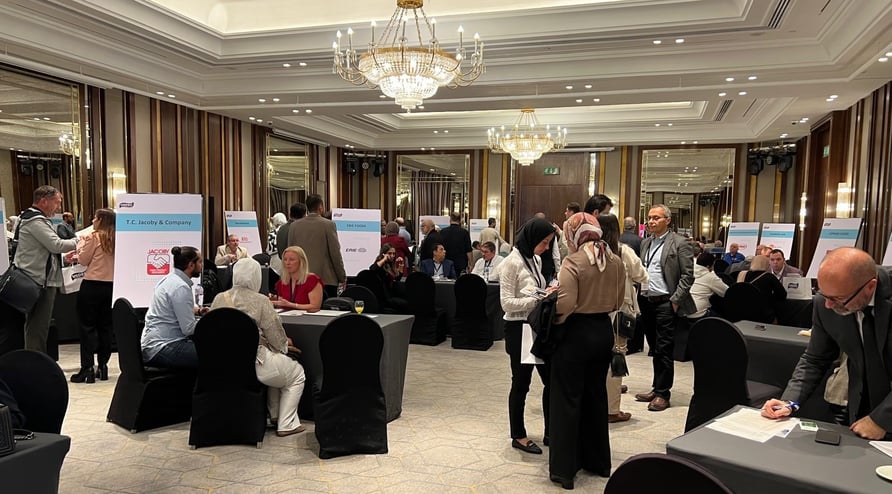
Meeting rooms at each of the stops on the mission (including this one in Cairo) were abuzz throughout the day with qualified buyers sitting down with U.S. cheese and dairy ingredients suppliers.
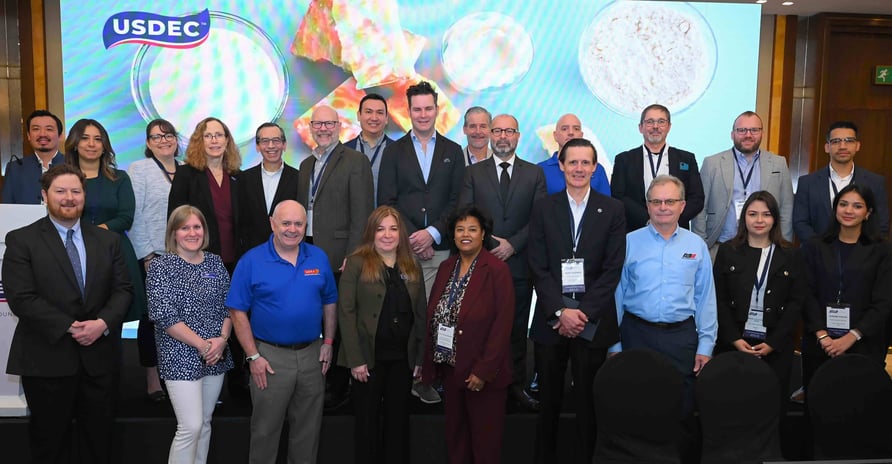
Participating USDEC staff and member representatives plus local FAS staff pose for a group photo prior to a busy day of buyer engagement in Cairo.
Each of the four days—one each in Cairo, Egypt, and Casablanca, Morocco, and two in Riyadh, Saudi Arabia (due to a larger number of buyer contacts)—kicked off with a market briefing that included:
- A welcome from Nina Bakht Halal, USDEC’s MENA office lead.
- A market presentation from the local USDA Foreign Agricultural Service (FAS) office.
- A recorded introduction to USDEC and U.S. dairy from President and CEO Krysta Harden.
- Comments from USDEC’s Vikki Nicholson-West, senior vice president, Global Ingredients Marketing, and Angélique Hollister, senior vice president, Global Cheese Marketing, on the value of U.S. ingredients and cheese and the commitment of U.S. suppliers.
The introduction was followed by five hours of scheduled one-on-one meetings (plus an hour for lunch). Members and buyers offered positive comments on the mission.
In the words of one U.S. member who participated: “We met more people/buyers in each city—Riyadh, Cairo and Casablanca—than we could have expected … It says so much that so many member companies can participate and work together for the greater good. The mission created immediate returns for the companies represented, for dairy processors/manufacturers and for U.S. dairy farmers.”
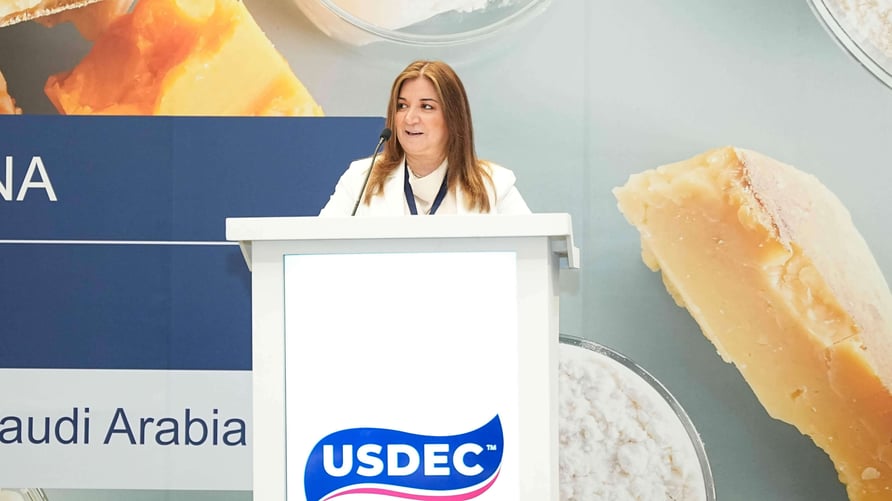
Nina Bakht Halal greets attendees and lays out the day’s agenda at one of the Riyadh sessions.
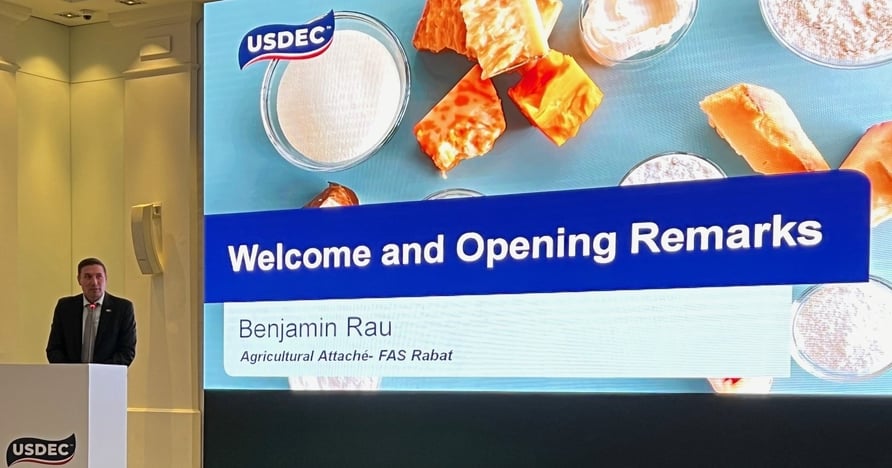
Ben Rau, U.S. agricultural attaché in Casablanca, provides a brief rundown of the Morocco market to attendees. FAS representatives spoke in each of the markets during the mission. Chris Riker provided a market briefing in Cairo and Chris Frederick presented in Riyadh.
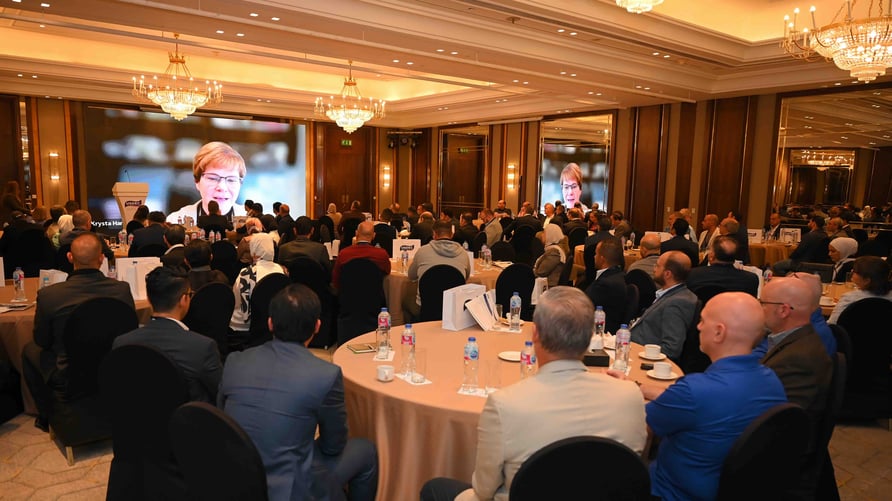
Krysta Harden welcomes MENA dairy buyers virtually in Cairo.
USDEC mission to Mexico seeks to reinforce ties ahead of change in U.S. leadership
USDEC held several meetings this week in Mexico with government agencies and stakeholders from throughout the dairy supply chain to reinforce the U.S.-Mexico dairy trade relationship ahead of the change in U.S. administrations. Jaime Castaneda, USDEC executive vice president, Policy Development and Strategy, traveled to Mexico City to engage with a cross-section of officials and business leaders, including farmers, dairy and food processors, importers, retailers and government agencies.
Castaneda reassured all parties that USDEC would continue to work with the Mexican and U.S. governments to facilitate dairy trade between the two countries and also continue to work with the local industry to bolster dairy consumption for the benefit of the dairy sectors and consumers on both sides of the border. He also discussed the issue of common food names to ensure that the rights of U.S. dairy suppliers to use those names in Mexico continued unabated.
Dairy Farmers of Wisconsin CEO Chad Vincent joined Castaneda to enhance the commitment of the U.S. partnership with Mexico and consider further collaboration with USDEC in the country.
The trip included meetings with representatives from Mexico’s Agriculture and Economics departments as well as the U.S-Mexico binational dairy working group, with which USDEC and NMPF have a longstanding relationship. That group includes Confederación Nacional de Organizaciones Ganaderas (CNOG), Asociación Mexicana de Productores de Leche (AMLAC), Cámara Nacional de Industriales de la Leche (CANILEC), and Consejo Nacional Agropecuario (CNA).
Cheese continues its hot streak in October
October U.S. dairy exports declined 2% year-over-year (YOY) in milk solids equivalent (MSE) terms. While U.S. cheese exports continued to soar, disadvantageous U.S. prices on low-protein whey and nonfat dry milk/skim milk powder (NFDM/SMP) created headwinds for U.S. suppliers, particularly in Southeast Asia.
U.S. export value was a different story. Elevated commodity prices and ongoing improved sales of higher value products like cheese and high-protein whey (WPC80+) lifted October U.S. dairy export value by 11% to $695.7 million.
Cheese and high-protein whey (WPC80+) remain the stars of the show.
U.S. cheese exports rose 12% (+4,455 MT) to 40,283 MT in October. It was the seventh time this year that U.S. shipments topped 40,000 MT. Mexico again led the gain, as volume jumped 27% (+3,693 MT), but widespread geographic growth characterized the month.
After an uncharacteristic 1% YOY decline in September, WPC80+ exports bounced back in October, climbing 25% (+2,153 MT). The September decline was the first September 2023, and the quick rebound the following month would normally suggest a temporary blip if it weren’t for signs of price resistance in key markets and questions about low-protein whey destined for China being misclassified as high-protein.
From a regional perspective, much of October’s decline can be attributed to a bad month in Southeast Asia. Total YOY U.S. NFDM/SMP volume dipped 4% in October (-2,808 MT), but sales to Southeast Asia fell 31% (-6,117 MT). Total YOY low-protein whey exports dropped 12% (-5,499 MT), and the bulk of that came from a 19% fall (-2,406 MT) in volume to Southeast Asia.
Those are sharp declines from a region that is the No. 2 U.S. customer for both products, particularly in light of the first three quarters of 2024. YOY U.S. NFDM/SMP exports to Southeast Asia were up 1% through September, and low-protein whey volume to the region was up 20% and running at a near-record pace after nine months.
For additional analysis, including deeper dives on cheese and whey, click on the U.S. Dairy Exporter Blog post, “U.S. exports fall 2% in October.” In addition, visit the USDEC Data Hub and click on the U.S. Exports tab for product-specific interactive charts on U.S. dairy trade trends.
Global plastics pollution meeting ends without agreement
The fifth session of the “Intergovernmental Negotiating Committee to Develop an International Legally Binding Instrument on Plastic Pollution, including in the Marine Environment” (INC-5) took place in Busan, South Korea, on Nov. 25-Dec. 1. The session was expected to be the last of five INC meetings, delivering a global plastics agreement. Instead, representatives from around the world agreed to adjourn and meet again at a later date.
Kelly Sheridan, USDEC’s vice president, Environmental Affairs, was on the ground to represent U.S. dairy during the talks. A plastics treaty has the potential to impact U.S. farm and food processing operations as well as the food packaging policies in many key U.S. dairy export markets. USDEC’s aim is to ensure that any binding actions consider the consequences of a heavy-handed plastics ban, reflect the diversity in livestock production systems around the world, and do not compromise safety or sacrifice productivity.
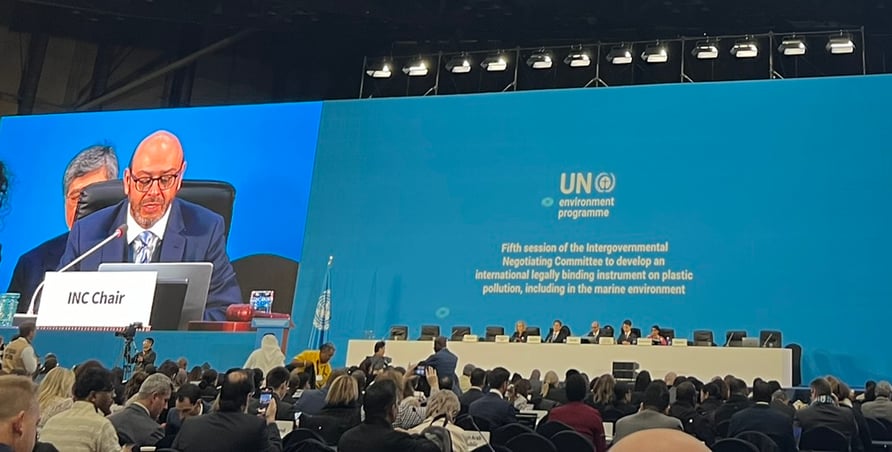
INC Chair Luis Vayas tells the crowd in Busan that an international legally binding instrument to address plastic pollution remained possible and urged delegates to show “unwavering commitment, relentless effort, and bold political will” to achieve that end.
Background
The INC was formed in 2022 when the UN Environment Assembly adopted resolution 5/14, initiating a multilateral process tasked with ending plastics pollution. The INC was created to develop an international legally binding instrument on plastic pollution, including in the marine environment. It has met five times since to discuss the scope of a plastics treaty and hammer out the details, including the approach and the principles for confronting the challenge, sustainable use of plastics, potential phase-outs and/or a global target on plastics production volume, and financial mechanisms to follow through on any plan.
Past meetings have yielded progress towards a treaty (see Global Dairy eBrief, 5/10/24) in the lead-up to Busan, but a deal remains elusive. INC-5 issued a Chair’s Text, but the document did not include a provision on scope and contained heavily bracketed text in several key areas. With so many unknowns and significant work remaining, details about how dairy and agriculture will be affected by a potential treaty remain unclear.
USDEC will continue to monitor progress on the Chair’s Text, which will be used as a starting point when the INC reconvenes. (INC-5.2, as it is being called, is expected to take place in July or August 2025.) USDEC is working diligently with allied organization, the U.S. government and other stakeholders to share the positive efforts the U.S. dairy industry has taken to manage plastics waste and to share potential unintended consequences of certain policy approaches on plastics.
If you would like to learn more about these global plastics issues or have examples of good practices or plastic initiatives your organization has developed, please contact Kelly Sheridan at ksheridan@usdec.org.
USDEC defends U.S. dairy positions at Codex conference
The 47th Session of Codex Alimentarius Commission (CAC47) took place Nov. 25-30 in Geneva, Switzerland. Once a year, the Commission gathers to approve or send back Codex standards and related text developed by specialized Codex Committees over the previous 12 months. USDEC plays an ongoing, active role in the Codex process throughout the year to ensure any new and revised standards remain science-based and dairy and trade friendly.
Nick Gardner, USDEC senior vice president, Sustainability and Multilateral Affairs, participated virtually in CAC47. Gardner attended as part of the International Dairy Federation (IDF) delegation representing his role as the Food Standards representative on the IDF Science and Programme Coordination Committee (SPCC), a position he was elected to during October’s IDF World Dairy Summit in Paris (see Global Dairy eBrief, 10/25/24).
This year’s meeting went smoothly with several items adopted by CAC that USDEC supported in the past year. USDEC continues to closely watch a new work proposal from the UAE to develop a specialized standard for camel milk. This would be the only species-specific milk standard in Codex and could have negative repercussions on other dairy standards. The Commission tasked New Zealand (as host country for the Codex Committee on Milk and Milk Products) and the UAE to conduct a gap analysis and review of the new work proposal before considering further action. USDEC will continue to follow this work closely and ensure existing dairy standards are not undermined as part of an International Dairy Federation action team formed on the topic.
The next CAC is slated to take place in Rome in November 2025.
Singapore court upholds generic use of “parmesan”
The Singapore Court of Appeals issued a definitive ruling affirming that the term “parmesan” remains a generic designation in Singapore revoking a previous decision by a lower court. The ruling arose from a challenge brought by Consortium for Common Food Names (CCFN) member Fonterra Co-operative Group and backed by CCFN. (CCFN was founded and is staffed by USDEC.)
The challenge was to the Consorzio del Formaggio Parmigiano Reggiano, which sought to monopolize the use of the term “parmesan” as a protected translation of “Parmigiano Reggiano” under Singapore’s Geographical Indications Act.
CCFN engaged with a law firm to support Fonterra in the appeals process and brought the issue to the attention of the U.S. and Singaporean governments. Backed by input from its members, CCFN gathered evidence on the widespread generic use of the term to help build an airtight argument that clearly demonstrated that consumers do not consider “parmesan” a translation of Parmigiano Reggiano and should be treated as a generic term. The appellate court agreed.
While the case sets a valuable precedent for intellectual property office worldwide, the EU continues its efforts to monopolize generic terms. CCFN and USDEC remain committed to advocating for U.S. dairy manufacturer rights to use common food and beverage names globally.
USDEC membership renewal notices mailed this week
USDEC emailed annual membership renewal notifications today. If you do not receive your invoice or if you have any questions about dues, please contact Weston Abels at wabels@usdec.org.
Market Summary
WMP, China drive GDT to third straight gain
The Global Dairy Trade (GDT) Price Index rose 1.2% at the Dec. 3 auction, marking its third straight gain. But with widespread declines across most products, the mood was not very bullish.
The primary driver behind the Price Index gain was China’s resurgent auction demand for WMP. The average winning WMP price rose 4.1% (to US$3,984/MT) offsetting declines in SMP (-1.0% to US$2,848/MT), butter (-5.2% to US$6,680/MT), AMF (-0.5% to US$7,583/MT), cheddar (-3.2% to US$4,689/MT) and mozzarella (-4.5% to US$4,120/MT).
China led all buyers in WMP, SMP, butter and cheddar—and taking 51% of aggregate auction volume. China’s dominance aligns with a GDT auction presence that has been ramping up since late spring. That presence, however, remains supply driven.
While the country has helped lead the GDT Price Index to eight gains in the past 10 auctions, it is not increased consumption that’s reinvigorated China’s auction appetite. Declining milk powder inventories, falling milk production (YOY output reportedly fell 7% in October) and a struggling domestic dairy farming sector have encouraged a renewed look to import markets to meet its needs—a situation likely to persist until China replenishes its stocks and/or the domestic sector turns around.
New Zealand sees benefit
We’ve previously noted in this section the dichotomy between China’s larger GDT presence and its still-dismal import numbers through October. With the release of October New Zealand export results, that increased GDT purchasing may finally be starting to show up in imports.
New Zealand exports to China are a rough indicator for following-month China imports (due to timing of shipments and customs recording).
Year-over-year (YOY) Kiwi WMP shipments to China more than doubled in October (+104%, +17,974 MT), the first YOY increase in seven months. Volume is still well down from China’s WMP peak purchasing years of 2019-21, but it was a step in the right direction.
YOY New Zealand exports of SMP to China rose 15% in October (+1,632 MT) after falling 21% and 72% in August and September, respectively.
New Zealand shipment of butterfat to China also jumped in October compared to the previous year. YOY butter volume more than doubled (+4,250 MT) and AMF exports rose 6% (+163 MT). Butter is one of the few categories where New Zealand exports to China were up year to date through October.
The one key category where China did not boost import purchases from New Zealand in October was cheese. YOY Kiwi cheese shipments to China plunged 23% (-2,303 MT) and were down 9% year to date (-7,884 MT).
Denmark signs deal for livestock emissions levy
After months of negotiations about how to implement the world’s first tax on emissions from livestock, Denmark’s parliament signed the Green Tripartite agreement, which was first announced in June (see Global Dairy eBrief, 6/28/24). The country’s major parties, farmers, industry representatives, trade unions and environmental groups all weighed in on the deal, which reportedly received a “broad majority” in parliament. Under the agreement, starting in 2030, farmers will pay 300 kroner (about US$42) for every ton of emissions their animals produce. That levy will go up to 750 kroner (about US$106) by 2035. (BBC, 11/18/24)
Market Access and Regulatory Affairs
USDEC makes 54 Export Guide document updates in November
The MARA team updated or revised 54 documents in the USDEC Export Guide last month. Here are some highlights:
Volume 2: Import Requirements
- Several countries: Updated APHIS Veterinary Certificate VS 16-4, outlining the new procedure by which APHIS stamps affidavits as received; then this stamped copy must be submitted with future certificate requests.
- EU: The Packaging Requirements section clarifies the sourcing requirements for recycled plastics used in packaging materials. Added a link to the Packaging and Packaging Waste Regulation (PPWR) corrigendum text and status update of the regulation, which was approved in the European Parliament in late November.
- India: Noted the implementation of the new integrated India Model Health Certificate on Nov. 1. No further extensions are expected.
- Vietnam: Updated Mandatory Testing/Inspection Upon Entry section to indicate that milk and processed milk products are categorized as “low risk products” and will be tested for Salmonella spp.
Volume 3: Labeling and Product Standards
- Bangladesh: Added new and revised standards for several dairy products, including butter, cheese, infant formula and sweetened condensed milk.
- Brazil: Several cheese documents now list a starch and modified starch allowance up to 1% in high-moisture cheeses (greater than or equal to 55% moisture).
- Thailand: Updated General Labeling document with requirements for GMO labeling, and serial number information; added labeling guidance to infant formula and follow-on formula and modified milk for infant's documents.
Every month, USDEC’s Market Access team emails a list of guide updates to interested members. If there is anyone at your company who should be included on the distribution list for that email in the future, please contact Jessica Smith at jsmith@usdec.org.
Trade Policy
China widens EU dairy probe
In mid-November, China said it was expanding the scope of its anti-subsidy investigation into EU dairy products. The country, which was reportedly looking into 20 different EU governmental programs, is adding about 13 more EU-wide and state schemes, including policies in Denmark, France, Italy and the Netherlands.
China held consultations with the EU in Mid-November about the additions to the probe. Products under investigation remain the same: fresh cheese and curd, processed cheese, blue cheese, and milk and cream (with a fat content of more than 10% by weight) that is not concentrated. (Reuters, 11/22/24)
Poland takes stance against EU-Mercosur deal
Poland Prime Minister Donald Tusk said his country joined France in opposition to the current form of the EU trade agreement with South America’s Mercosur countries (Brazil, Argentina, Paraguay and Uruguay). European farmers say the deal will subject them to unfair competition by allowing large imports of products that do not need to adhere to the same strict regulations they must meet in the EU.
The Prime Minister made the announcement before the start of a government meeting last week, around the same time that French farmers brought dozens of tractors near the European Parliament in Strasbourg in protest but were stopped by police before reaching their goal. Polish farmers have also started showing opposition to the deal: Protests were reported in 23 locations across the country earlier this week, the largest of which attracted more than 50 tractors to the northern city of Elbląg. Despite this growing opposition, German Foreign Minister Annalena Baerbock said this week it was "essential" for the EU to finalize the deal this week, and added that the Mercosur summit in Montevideo on Dec. 6 is “probably the last opportunity” to do so. (Buenos Aires Times, 12/3/24; Reuters, 11/26/24; Bloomberg, 11/22/24)
Company News
Bord Bia secures €3.2m campaign to promote dairy in Asia
Irish trade development group Bord Bia was awarded a €3.2 million (about US$3.4 million) contract to promote dairy in Asia for three years on behalf of the EU. The goal of the ‘European Dairy – Where Nature Meets Science’ campaign is to position the EU as a leader in the supply of value-add dairy ingredients to the specialized nutrition manufacturing sector across China, Singapore and Vietnam. Ireland will be promoting the campaign on behalf of the EU 27.
Bord Bia CEO Jim O’Toole said that EU co-funded campaigns are a vital means of putting Ireland on the global stage as a food producer, and that the initiative will focus on building new relationships between Irish exporters and local manufacturers of higher-value consumer products, as well as the importers and distributors in China, Singapore and Vietnam that serve them. The campaign will launch in June 2025. (Agriland, 11/19/24)
a2MC seeking more Chinese labels, own processing plant
New Zealand-based a2 Milk Co. (a2MC) said at its annual meeting this week that top priorities include securing more Chinese label registrations and developing its own nutritional manufacturing capability. Company chair Pip Greenwood said a2MC is exploring opportunities to achieve this through investment in its own supply chain and through acquisitions and commercial partnerships, and noted that the 2024 financial year was a milestone year for its China-label product, following re-registration in June 2023 of its upgraded China-label infant milk formula. (Rural News, 11/22/24)
Nestlé details cost of closing Limerick infant formula plant
Swiss food giant Nestlé said the decision to close its Wyeth Nutrition infant formula facility and R&D center in County Limerick, Ireland, cost €472 million (about US$496 million). When the company announced roughly a year ago that it would shutter the facility, which produces products exclusively for export to China and Asia, it said that external trends including China’s declining birth rate had impacted demand in the country. A Wyeth Nutritionals Ireland financial statement shows the company incurred the exceptional cost “due to the announcement of the closure. This includes both restructuring and impairment costs.” The closure will occur in phases, with R&D activities set to end in March 2025 and manufacturing continuing until the full closure in March 2026. (Agriland, 11/27/24)
Mergers, acquisitions and joint ventures
Following the decision of its parent company to spin off its ice cream business, Unilever’s India unit, Hindustan Unilever Ltd., said it will demerge and independently list its ice cream division. The business includes brands such as Kwality Wall’s, Cornetto and Magnum. … Private equity group Blackstone said it will acquire New Jersey-based sandwich chain Jersey Mike’s Subs in a deal reportedly valued at $8 billion. Blackstone said Jersey Mike’s Founder and CEO Peter Cancro will maintain a “significant equity stake” in the company and will continue to lead the business. (FoodBev Media, 11/27/24; Restaurant Business, 11/19/24)
Company briefs
After Bloomberg reported Seattle-based Starbucks was exploring options for its Chinese operations (including determining interest from potential investors), CEO Brian Niccol said the company is working to find the best path to growth and will “continue to explore strategic partnerships that could help us grow in the long term.” … In a move toward “developing sustainable supply chains for food production,” Brazil-based meat company JBS signed a Memorandum of Understanding with the government of Nigeria saying it will invest $2.5 billion in the country in the next five years. The plan includes the construction of six new factories—three for poultry, two for beef and one for pork—to reduce imports and improve food security. … After “carefully assessing” long-term changes in milk production and demand, Dairy Farmers of America said it will cease manufacturing operations at its Goshen, Indiana, plant next month. Milk currently processed at the plant, which manufactures condensed milk for B2B customers, will be redirected to nearby facilities. … To support the development of Mongolia’s agribusiness sector, the European Bank for Reconstruction and Development (EBRD) is granting a US$20 million loan to APU Dairy—the country’s second largest producer of dairy products. The loan will help APU finance the expansion of its processing plant, the acquisition of new processing and packaging lines, and the upgrading and expansion of its milk sourcing arrangements, as well as helping to meet its working capital needs. … Sydney-based biotech company All G gained regulatory approval to sell its precision-fermented recombinant (made from microbes, not cows) lactoferrin protein in China. The company aims to launch its first products in the market in the second half of 2025. (EBDR; Food & Drink Business, 11/27/24; Reuters, 11/21/24; Just Food, 11/21/24)
In Case You Missed It...
U.S. Dairy Exporter Blog
Market analysis, research and news subscribe hereUSDEC Twitter feed
Follow us here.